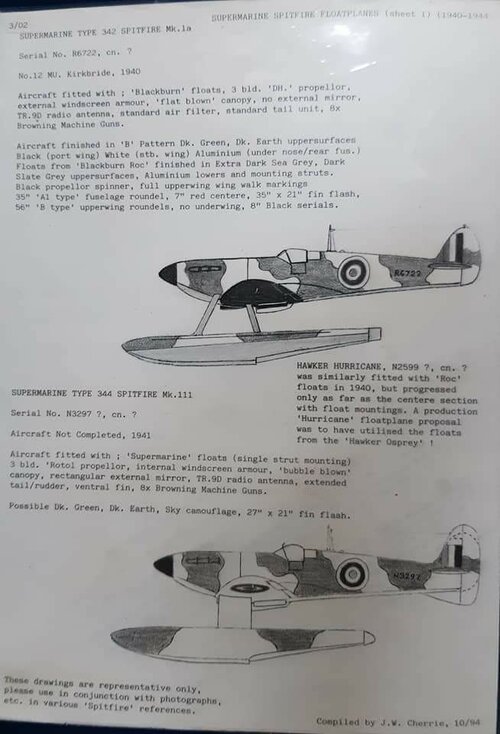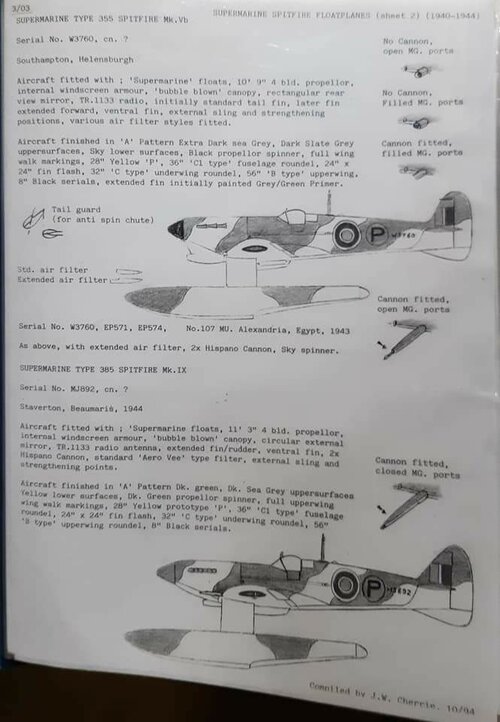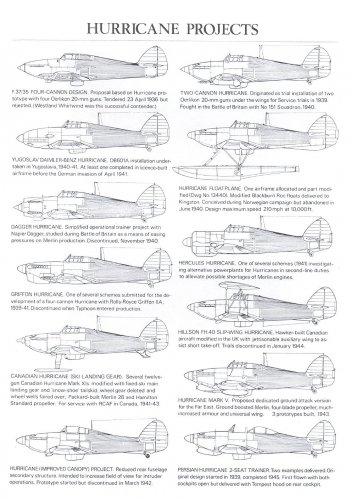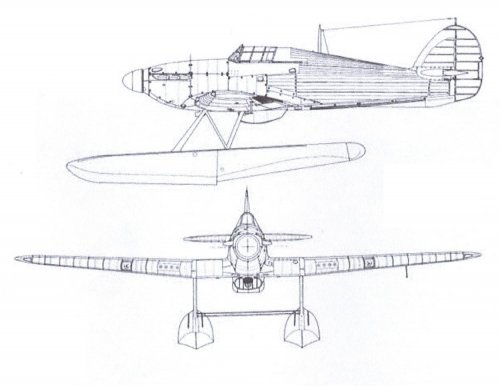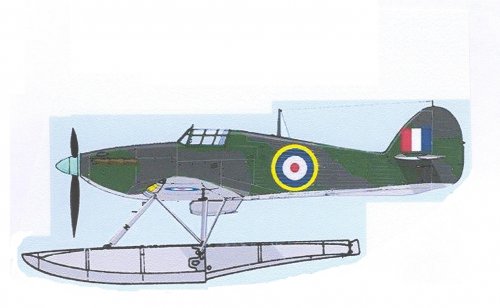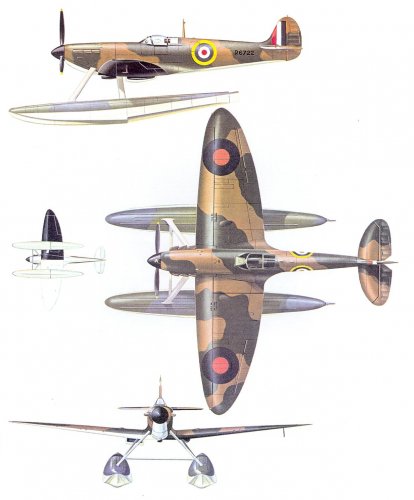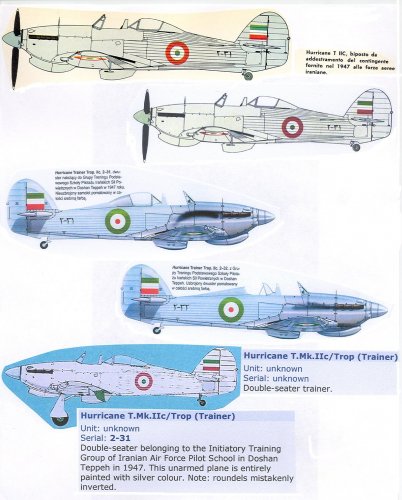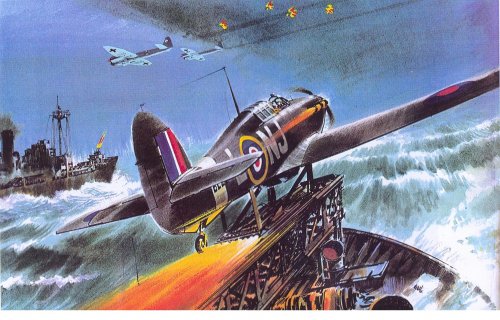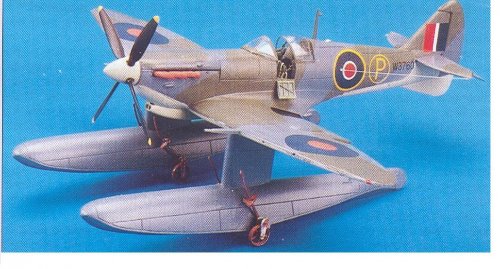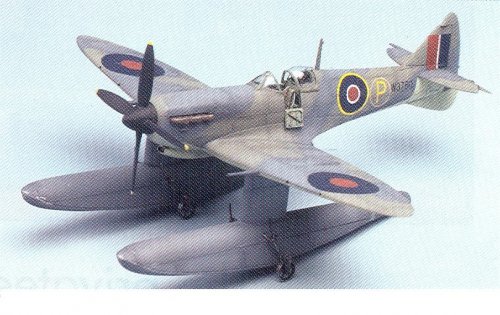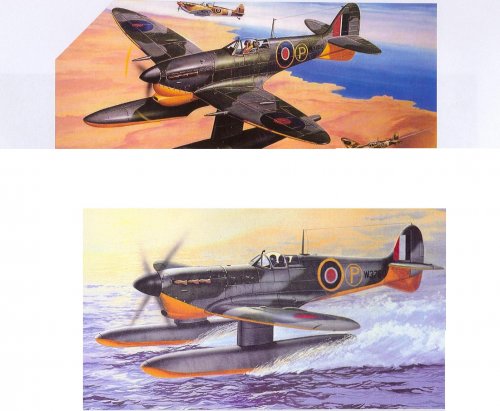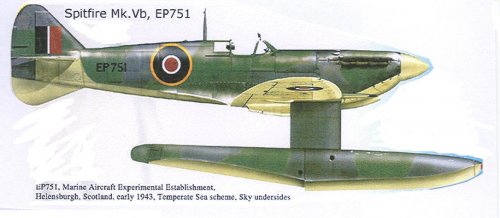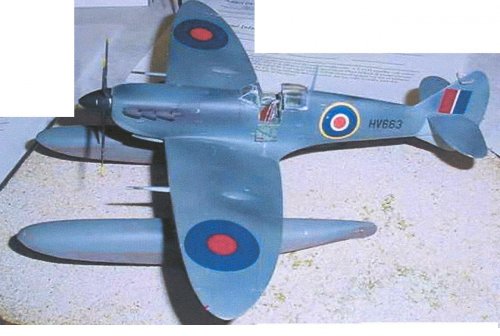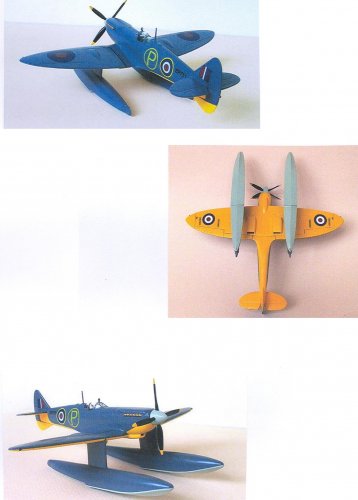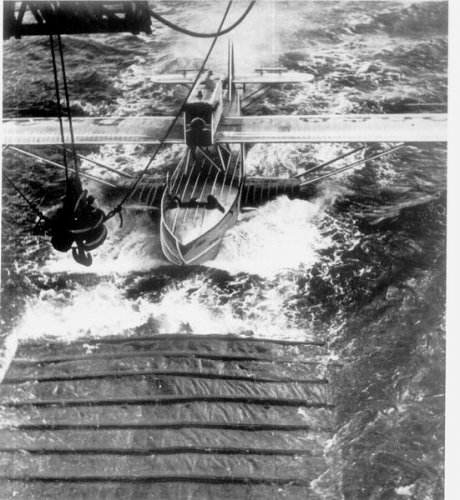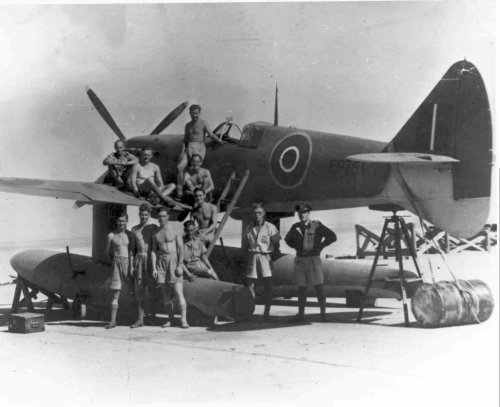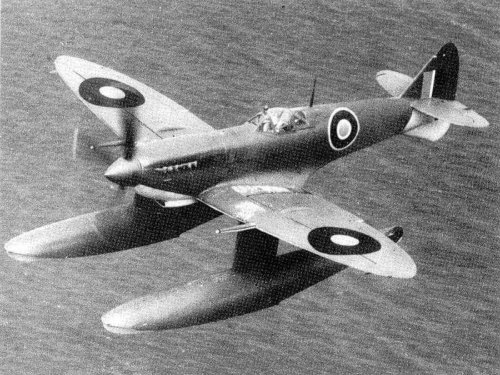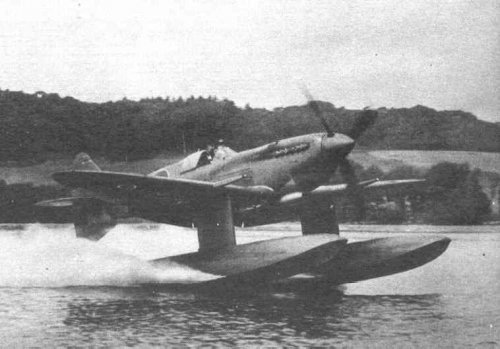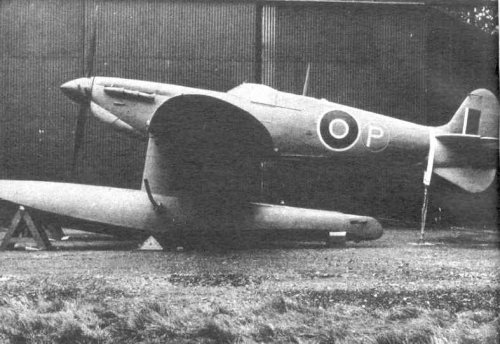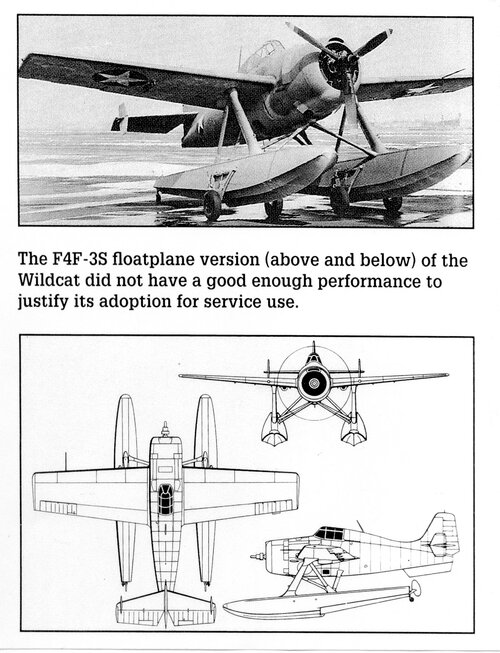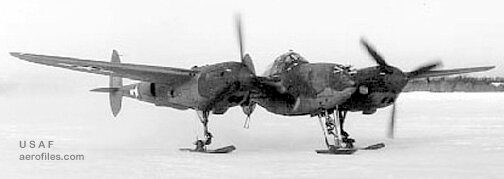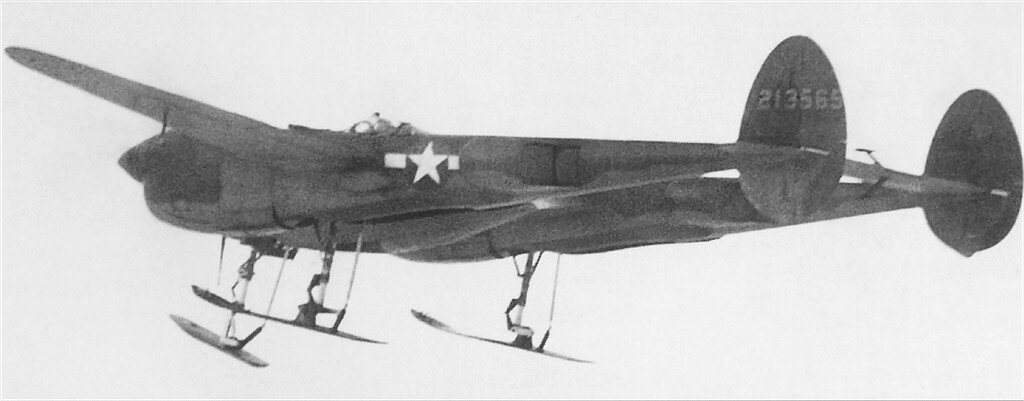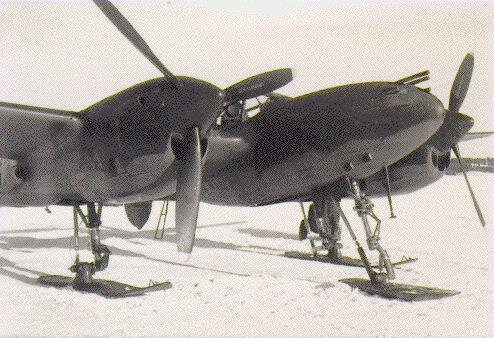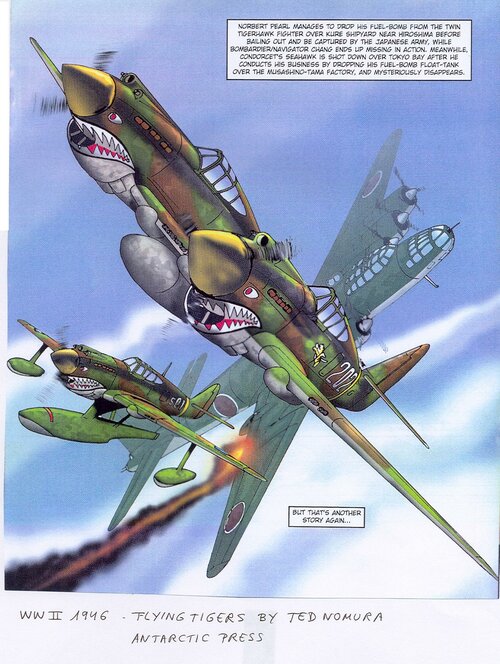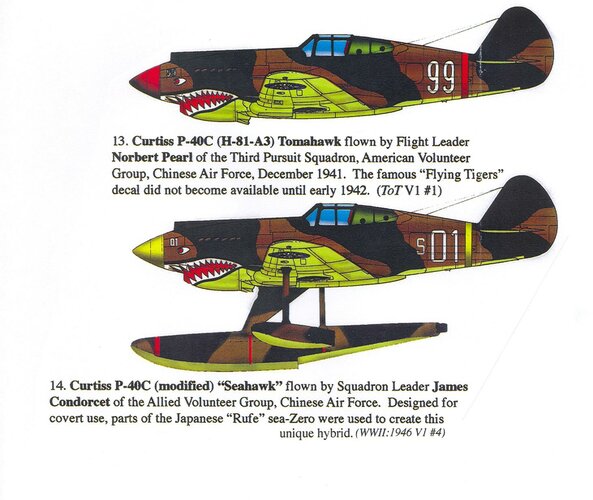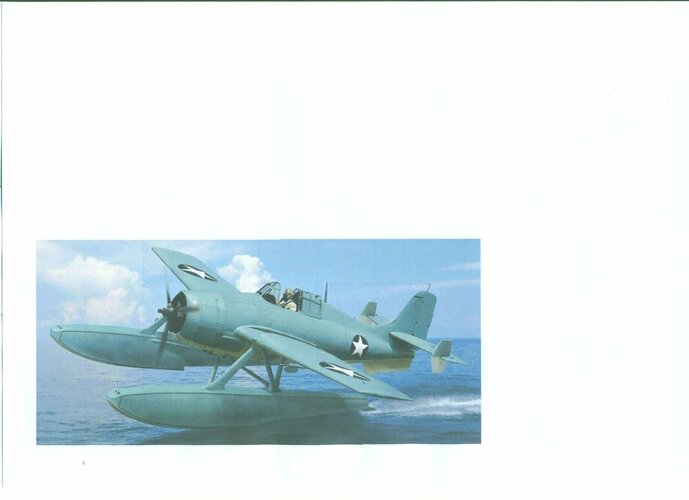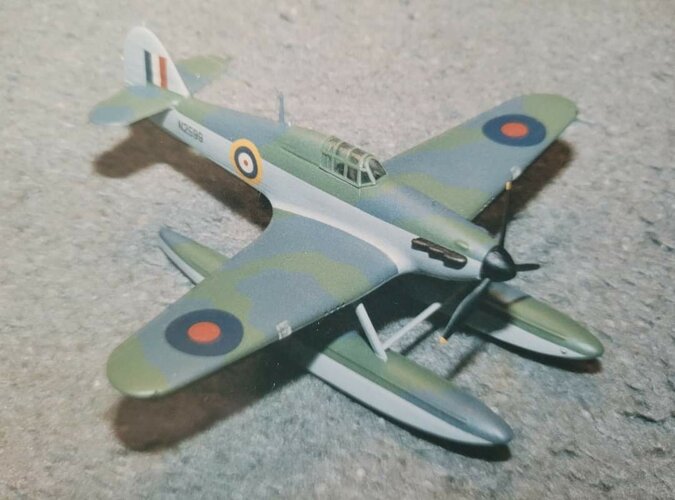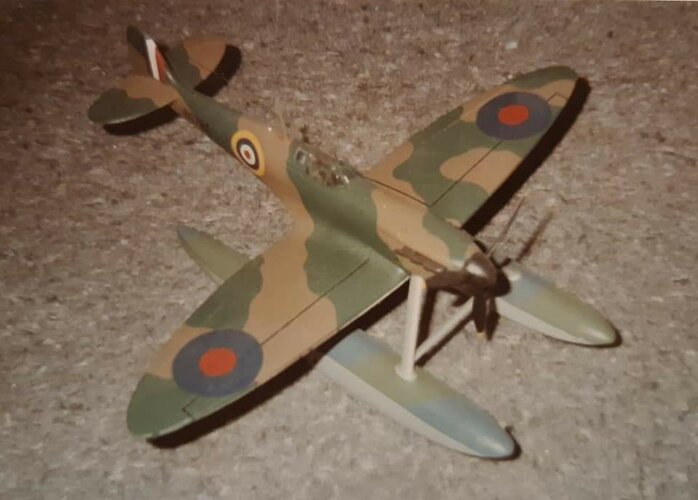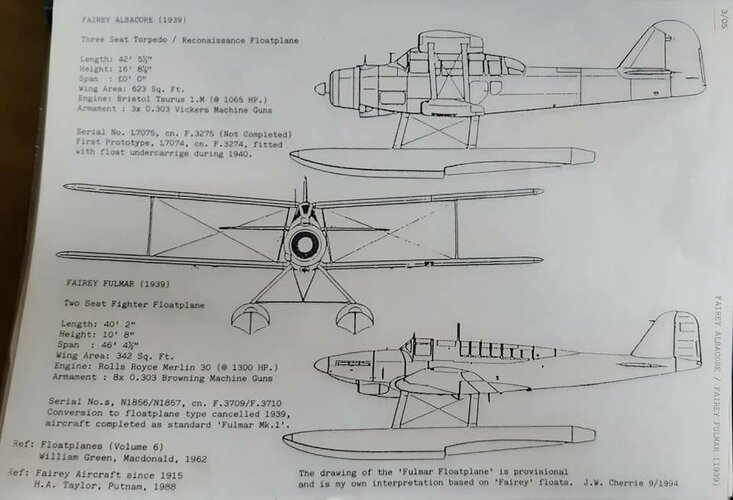You are using an out of date browser. It may not display this or other websites correctly.
You should upgrade or use an alternative browser.
You should upgrade or use an alternative browser.
Spitfire / Hurricane / Kittyhawk / Gladiator / Lysander floatplanes ...
- Thread starter TsrJoe
- Start date
- Joined
- 25 July 2007
- Messages
- 3,977
- Reaction score
- 3,429
Thanks Joe!
Mason said in The British Fighter Since 1912 that Roc floats were delivered to Hawker sometime after April 1940 "and no such Hurricane was completed". Does anyone know whether the actual conversion work was begun or was this concept strictly design only?
Mason said in The British Fighter Since 1912 that Roc floats were delivered to Hawker sometime after April 1940 "and no such Hurricane was completed". Does anyone know whether the actual conversion work was begun or was this concept strictly design only?
Mhh, what kind of seaplane hanger could you get in the space of the two aft 15" turrets on the Royal Sovereign class battleships....RN equivalents of the Japanese Ise class but for convoy escort - float equipped Swordfish for A/S and later, float equipped Hurricanes and/or Spitfires to give the Condors a nasty surprise.......... 
red admiral
ACCESS: Top Secret
- Joined
- 16 September 2006
- Messages
- 1,532
- Reaction score
- 1,688
Some details here
"The first Spitfire floatplane was a conversion of a Mark I, the so called "Narvik Nightmare" R6722 which was produced at the time of the German invasion of Norway where there emerged a requirement for a fighter capable of flying from the Fjords in view of the lack of suitable airfields in the country.
In the interests of speed, floats from a Blackburn Roc were fitted but the trials were not successful and as the campaign for which the conversion was required was rapidly drawing to a close the project was suspended."
"The first Spitfire floatplane was a conversion of a Mark I, the so called "Narvik Nightmare" R6722 which was produced at the time of the German invasion of Norway where there emerged a requirement for a fighter capable of flying from the Fjords in view of the lack of suitable airfields in the country.
In the interests of speed, floats from a Blackburn Roc were fitted but the trials were not successful and as the campaign for which the conversion was required was rapidly drawing to a close the project was suspended."
- Joined
- 11 March 2006
- Messages
- 8,640
- Reaction score
- 3,286
"...float equipped Swordfish for A/S and later, float equipped Hurricanes and/or Spitfires to give the Condors a nasty surprise"
I can imagine, that the concept of the seaplane carrier as a convoy escort wasn't seen with
much enthusiasm at that time ! For recovering the aircraft, the ship at least would have had
to slow down, if not to stop. A gift for every Uboat in vicinity ! ;D
I can imagine, that the concept of the seaplane carrier as a convoy escort wasn't seen with
much enthusiasm at that time ! For recovering the aircraft, the ship at least would have had
to slow down, if not to stop. A gift for every Uboat in vicinity ! ;D
- Joined
- 11 March 2006
- Messages
- 8,640
- Reaction score
- 3,286
That's correct, but the starting point was, a R-class seaplane carrier as a convoy
escort and this, I think, implies at least a fear of Uboats.
Another point would have been the landing and recovery of a floatplane at sea,
something that, AFAIK, isn't as trivial as it may seem.
escort and this, I think, implies at least a fear of Uboats.
Another point would have been the landing and recovery of a floatplane at sea,
something that, AFAIK, isn't as trivial as it may seem.
"I can imagine, that the concept of the seaplane carrier as a convoy escort wasn't seen with
much enthusiasm at that time ! For recovering the aircraft, the ship at least would have had
to slow down, if not to stop. A gift for every Uboat in vicinity ! "
Catafighter is best solution...
much enthusiasm at that time ! For recovering the aircraft, the ship at least would have had
to slow down, if not to stop. A gift for every Uboat in vicinity ! "
Catafighter is best solution...
Attachments
- Joined
- 11 March 2006
- Messages
- 8,640
- Reaction score
- 3,286
"Catafighter is best solution..."
In a seastate as in the picture you've posted, the loss rate of
Catafighters against a floatplane fighters probably would have
been more or less the same ...
In a seastate as in the picture you've posted, the loss rate of
Catafighters against a floatplane fighters probably would have
been more or less the same ...
Jemiba said:"Catafighter is best solution..."
In a seastate as in the picture you've posted, the loss rate of
Catafighters against a floatplane fighters probably would have
been more or less the same ...
I agree
Jemiba said:"...float equipped Swordfish for A/S and later, float equipped Hurricanes and/or Spitfires to give the Condors a nasty surprise"
I can imagine, that the concept of the seaplane carrier as a convoy escort wasn't seen with
much enthusiasm at that time ! For recovering the aircraft, the ship at least would have had
to slow down, if not to stop. A gift for every Uboat in vicinity ! ;D
The Aircraft Carrier Story 1908 - 1945 by Guy Robbins suggests that by the end of 1918, a way had been developed that would enable floatplanes to be recovered without the ship stopping. However, he doesn't elaborate how or say what speed was possible.
- Joined
- 11 March 2006
- Messages
- 8,640
- Reaction score
- 3,286
"..that would enable floatplanes to be recovered without the ship stopping.."
Such a system was used, too, to recover the Dornier Wal flying boats, serving
postal service from europe to america, onto the "Katapultschiffe" (catapultships).
It was called "Schleppsegel" (towed sail), which was made of fabric and towed
behind, or at the side of the ship, so the wake was used to stabilise this slack
construction and hold the flyingboat at its place.
Nevertheless system was limited to relativelylow seastates and course and speed
had to be set according to wind and weatherconditions !
(photo from F.Gütschow "Die deutschen Flugboote")
Such a system was used, too, to recover the Dornier Wal flying boats, serving
postal service from europe to america, onto the "Katapultschiffe" (catapultships).
It was called "Schleppsegel" (towed sail), which was made of fabric and towed
behind, or at the side of the ship, so the wake was used to stabilise this slack
construction and hold the flyingboat at its place.
Nevertheless system was limited to relativelylow seastates and course and speed
had to be set according to wind and weatherconditions !
(photo from F.Gütschow "Die deutschen Flugboote")
Attachments
The Hein mat, I think. I have a recollection that the French La Galissonniere class cruisers could pull this trick, but I can't remember where I read it.a way had been developed that would enable floatplanes to be recovered without the ship stopping.
See
http://www.steelnavy.com/1250DLHships.htm
http://rhs.akdreemer.com/RHS%20Scenarios/Misc%20RHS%20Items/RHS_Handbook.pdf where it says (and no more)
As forthe Chitose's were ... ... also able to operate an air group of seaplanes –. using a Hein Mat for underway recovery.
just about every capital ship and cruiser carried at least one spotter floatplanethe landing and recovery of a floatplane at sea,
something that, AFAIK, isn't as trivial as it may seem.
before radar was introduced. The RN actually used one at the River Plate action IIRC.
Maybe not trivial, but routine. There were cranes for the job.
Spotters are not nearly as big and heavy as Dornier Wals.
I've also found http://smmlonline.com/archives/VOL0923.txt
The Hein Mat recovery system used a mat on a roller that was unrolled directly astern the recovery ship. It was tried by several European navies but was discarded by the beginning of WWII. This should not be confused with the U.S. Navy system in which the recovery ship steamed in an arc into the wind to create a slick for the floatplane to land. A bright yellow sled was let out on a cable off to one side of the ship. A barb-like hook on the bottom of the central float engaged a cargo net on top of the sled and then sled and attached plane were hauled in to the side of the ship where a crane lifted the aircraft back aboard. Although not without problems, this system was successful enough to be used from the 1920's until the end of the
floatplane era after WWII.
- Joined
- 11 March 2006
- Messages
- 8,640
- Reaction score
- 3,286
Of course floatplanes and smaller flying boats were standard on larger warships
and, yes, I know that during the battle at La Plata a SeaFox did succesfully artillery
spotting and at Narvik a Swordfish on floats did the same for HMS Warspite.
During a battle, when there's no other methode for spotting and recce, it doesn't
really matter, if the aircraft can be recovered more or less intact, I think.
But a convoy escort like a hybrid R-class would have to launch aircraft on a regular
basis, for ASW the mentioned Swordfish and fighters for something like CAP. It
probably would have been a different situation to accompany a convoy on route through
the northern atlantic, than to search for a lonely raider in the pacific or indian ocean.
Pilots of flying boats had developed a technique to stall their aircraft some feet above
the sea surface and so were able to operate at quite high seastates (this is mentioned
in reports about SAR operations with Walrus flying boats), but I'm pretty sure, this wouldn't
have worked with floatplanes !
Maybe the best point against a seaplane carrier as means to keep aircraft over the open sea
is just ... that there weren't used in this way !
But, BTW ... what this thread started with ?
and, yes, I know that during the battle at La Plata a SeaFox did succesfully artillery
spotting and at Narvik a Swordfish on floats did the same for HMS Warspite.
During a battle, when there's no other methode for spotting and recce, it doesn't
really matter, if the aircraft can be recovered more or less intact, I think.
But a convoy escort like a hybrid R-class would have to launch aircraft on a regular
basis, for ASW the mentioned Swordfish and fighters for something like CAP. It
probably would have been a different situation to accompany a convoy on route through
the northern atlantic, than to search for a lonely raider in the pacific or indian ocean.
Pilots of flying boats had developed a technique to stall their aircraft some feet above
the sea surface and so were able to operate at quite high seastates (this is mentioned
in reports about SAR operations with Walrus flying boats), but I'm pretty sure, this wouldn't
have worked with floatplanes !
Maybe the best point against a seaplane carrier as means to keep aircraft over the open sea
is just ... that there weren't used in this way !
But, BTW ... what this thread started with ?
What about the pilot?During a battle, when there's no other methode for spotting and recce, it doesn't
really matter, if the aircraft can be recovered more or less intact, I think.
Jemiba asked
But, BTW ... what this thread started with ?
http://www.nationalarchives.gov.uk/catalogue/displaycataloguedetails.asp?CATID=3121307&CATLN=6&Highlight=&FullDetails=True
To get any more you would have to visit TNA or order a copy
IIRC these Spitfire variants were intended to operate from sheltered waters rather than seaplane carriers, the MkV for the Aegean? I'd need to look it up in Shacklady's Spitfire book.
- Joined
- 11 March 2006
- Messages
- 8,640
- Reaction score
- 3,286
"What about the pilot?"
Good question, but when we remember the catafighters, the pilot had
to ditch or to bail out near his convoy, as long, a he hadn't land within
his range. Both methods generally regarded as dangerous, I think, but
as much more tan a singe live was endangered, it was regarded as an
acceptable risk. And the same probably was true for actions like artillery
spotting during a battle. But during routine patrol flights ?
My question, about the starting point of this thread, was meant more or less
ironically, as we have drifted from some float fighter projects to the suitability
of floatplane carriers for escort duties.
The reasons for the spitfire floatplane conversions are summed up here, too :
http://www.supermarine-spitfire.co.uk/spitfire_floatplane.htm
Good question, but when we remember the catafighters, the pilot had
to ditch or to bail out near his convoy, as long, a he hadn't land within
his range. Both methods generally regarded as dangerous, I think, but
as much more tan a singe live was endangered, it was regarded as an
acceptable risk. And the same probably was true for actions like artillery
spotting during a battle. But during routine patrol flights ?
My question, about the starting point of this thread, was meant more or less
ironically, as we have drifted from some float fighter projects to the suitability
of floatplane carriers for escort duties.
The reasons for the spitfire floatplane conversions are summed up here, too :
http://www.supermarine-spitfire.co.uk/spitfire_floatplane.htm
Ditching near a convoy means being picked up by a small escort. Spotting in a cruiser gun battle it is much less likely that a ship could stop. Routine patrols? Recovering the plane means stopping and being a sitting target for subs. That means ASW patrol is ineffective?
But I agree, such floatplanes would be Stringbags, not Spitfires.
But I agree, such floatplanes would be Stringbags, not Spitfires.
T
thehortenlead
Guest
TsrJoe said:file DSIR 23/10553 at the UK. National Archives (original file dated 25 September 1940)
cheers, Joe
Sweet plane ! Very good post....
Thanks, Tim
Ed_Moorman
ACCESS: Restricted
- Joined
- 1 August 2008
- Messages
- 2
- Reaction score
- 3
Ed_Moorman
ACCESS: Restricted
- Joined
- 1 August 2008
- Messages
- 2
- Reaction score
- 3
I also found the text to go with the photos. I could not locate the origin or the author.
"SPITFIRE FLOATPLANE
Having been originally developed from the Supermarine S6B it is perhaps natural that the Spitfire should be developed for use on water.
The first Spitfire floatplane was a conversion of a Mark I, the so called "Narvik Nightmare" R6722 which was produced at the time of the German invasion of Norway where there emerged a requirement for a fighter capable of flying from the Fjords in view of the lack of suitable airfields in the country.
In the interests of speed, floats from a Blackburn Roc were fitted but the trials were not successful and as the campaign for which the conversion was required was rapidly drawing to a close the project was suspended.
The idea was revived again with the beginning of the war in the Pacific against Japan when it was realized that a floatplane fighter with good performance would be an essential asset in the island campaigns which seemed likely.
Folland Aircraft undertook the conversion of a Spitfire Mk Vb, W3760, with Supermarine designed floats and this aircraft proved an immediate success with a top speed of 324 mph. In this aircraft the carburetor air intake was extended to avoid spray, a shorter four blade propeller was fitted, cantilever pylons attached the floats to the inboard wing sections, a ventral fin replaced the tail wheel and the fin was extended slightly forward to increase the vertical tail surface area.
Mark V conversion (Original Fin)
Folland built several sets of floats and converted another two Mark V aircraft, EP751 and EP754. These together with W3760 were shipped to Egypt in 1943 and assembled with the intention of covertly operating them out of small Greek islands to intercept German transport aircraft. (Note original fin and added sub fin.)
Spitfire Floatplane EP751 - photograph taken in the Middle East and kindly provided by Terry Cheeseman - his Father, E P Cheeseman is sitting on the far left. (Extended Fin)
Spitfire Floatplane MkIX - MJ892 (Note fin change)
SUPERMARINE SPITFIRE FLOATPLANE
A further Spitfire was converted in 1944, a Mark IX serial MJ892 powered by a Merlin 45. The performance of this aircraft was superb and with a top speed of 377 mph the fastest floatplane of the entire war.
SUPERMARINE SPITFIRE FLOATPLANE - Floatplane fighter version of Supermarine Spitfire initiated during 1942, based on Mk VB airframe using floats designed by Supermarine (as Supermarine Type 355). Conversion by Folland Aircraft, with four-bladed propeller on Merlin 45 engines, tropical filter and extra ventral fin. First flown October 12, 1942, and later fitted with extra dorsal fin and Aero-Vee tropical filter. Two further Mk VB conversions by Folland during 1943; all three to Egypt late-1943 and flown from Great Bitter Lake, but no operational use. One Supermarine Spitfire LF Mk IXB, with Merlin 66 and four-bladed propeller (Type 385), similarly converted by Folland, first flown June 18, 1944, later reconverted to land-plane.
Data for Mk VB floatplane: Max speed, 324 mph (521 km/h) at 19,500ft (5,944 m). Initial climb, 2,240 ft/min (11.38 m/sec). Service ceiling (estimated), 33,400 ft (10,180 m). Empty weight, 6,014 Ib (2,728 kg). Gross weight, 7,580 Ib (3,438 kg). Span, 36ft 0 in (11.23 m). Length, 35ft 4 in (10.76m)."
"SPITFIRE FLOATPLANE
Having been originally developed from the Supermarine S6B it is perhaps natural that the Spitfire should be developed for use on water.
The first Spitfire floatplane was a conversion of a Mark I, the so called "Narvik Nightmare" R6722 which was produced at the time of the German invasion of Norway where there emerged a requirement for a fighter capable of flying from the Fjords in view of the lack of suitable airfields in the country.
In the interests of speed, floats from a Blackburn Roc were fitted but the trials were not successful and as the campaign for which the conversion was required was rapidly drawing to a close the project was suspended.
The idea was revived again with the beginning of the war in the Pacific against Japan when it was realized that a floatplane fighter with good performance would be an essential asset in the island campaigns which seemed likely.
Folland Aircraft undertook the conversion of a Spitfire Mk Vb, W3760, with Supermarine designed floats and this aircraft proved an immediate success with a top speed of 324 mph. In this aircraft the carburetor air intake was extended to avoid spray, a shorter four blade propeller was fitted, cantilever pylons attached the floats to the inboard wing sections, a ventral fin replaced the tail wheel and the fin was extended slightly forward to increase the vertical tail surface area.
Mark V conversion (Original Fin)
Folland built several sets of floats and converted another two Mark V aircraft, EP751 and EP754. These together with W3760 were shipped to Egypt in 1943 and assembled with the intention of covertly operating them out of small Greek islands to intercept German transport aircraft. (Note original fin and added sub fin.)
Spitfire Floatplane EP751 - photograph taken in the Middle East and kindly provided by Terry Cheeseman - his Father, E P Cheeseman is sitting on the far left. (Extended Fin)
Spitfire Floatplane MkIX - MJ892 (Note fin change)
SUPERMARINE SPITFIRE FLOATPLANE
A further Spitfire was converted in 1944, a Mark IX serial MJ892 powered by a Merlin 45. The performance of this aircraft was superb and with a top speed of 377 mph the fastest floatplane of the entire war.
SUPERMARINE SPITFIRE FLOATPLANE - Floatplane fighter version of Supermarine Spitfire initiated during 1942, based on Mk VB airframe using floats designed by Supermarine (as Supermarine Type 355). Conversion by Folland Aircraft, with four-bladed propeller on Merlin 45 engines, tropical filter and extra ventral fin. First flown October 12, 1942, and later fitted with extra dorsal fin and Aero-Vee tropical filter. Two further Mk VB conversions by Folland during 1943; all three to Egypt late-1943 and flown from Great Bitter Lake, but no operational use. One Supermarine Spitfire LF Mk IXB, with Merlin 66 and four-bladed propeller (Type 385), similarly converted by Folland, first flown June 18, 1944, later reconverted to land-plane.
Data for Mk VB floatplane: Max speed, 324 mph (521 km/h) at 19,500ft (5,944 m). Initial climb, 2,240 ft/min (11.38 m/sec). Service ceiling (estimated), 33,400 ft (10,180 m). Empty weight, 6,014 Ib (2,728 kg). Gross weight, 7,580 Ib (3,438 kg). Span, 36ft 0 in (11.23 m). Length, 35ft 4 in (10.76m)."
Boogey
B'Boomelang
- Joined
- 10 February 2009
- Messages
- 200
- Reaction score
- 32
Was the Type 356 number credit to both land and float Mk. XXI versions ?TsrJoe said:Serial numbers for the allocated floatplane Hurricane and Spitfire conversions ...
Hawker (Langley) Hurricane Mk.1, N2599
Supermarine Type 342 Spitfire Mk.1, R6722
Supermarine Type 344 Spitfire Mk.III, N3297
Supermarine Type 355 Spitfire Mk.Vb, W3760
Supermarine Type 355 Spitfire Mk.Vb, EP571
Supermarine Type 355 Spitfire Mk.Vb, EP574
Supermarine Type 385 Spitfire Mk.IX, MJ892
Supermarine Type 356 Spitfire Mk.21, project only
Supermarine Type 542 Attacker, project only
cheers, Joe
BlackBat242
OK, I changed my personal text ;)
- Joined
- 10 April 2013
- Messages
- 1,011
- Reaction score
- 2,601
HiView attachment 691074
While no P-38 was ever fitted with floats, they did go skiing!
P-38G
View attachment 691076
P-38J
View attachment 691075
View attachment 691077
Attachments
P-40 on Floats Study
While researching EDO Floats I came across this file and went ahead and copied it. I have never heard of this, but I would love to have seen one.
Attachments
-
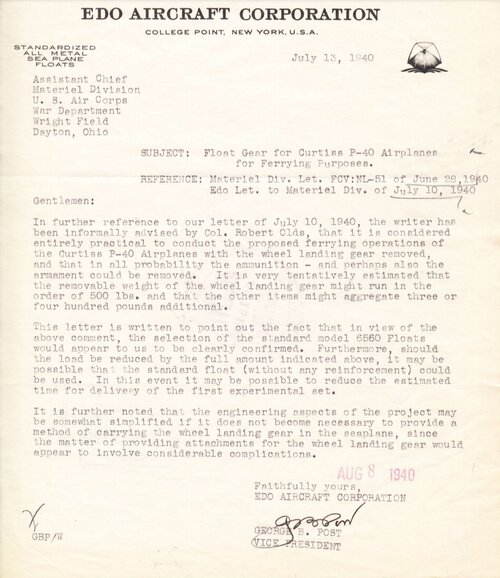 Screenshot_20230131_000227_Microsoft 365 (Office).jpg322.3 KB · Views: 30
Screenshot_20230131_000227_Microsoft 365 (Office).jpg322.3 KB · Views: 30 -
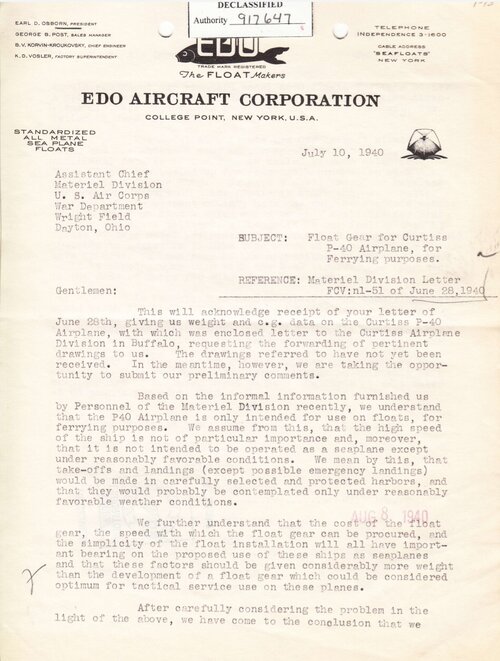 Screenshot_20230131_000237_Microsoft 365 (Office).jpg388.5 KB · Views: 27
Screenshot_20230131_000237_Microsoft 365 (Office).jpg388.5 KB · Views: 27 -
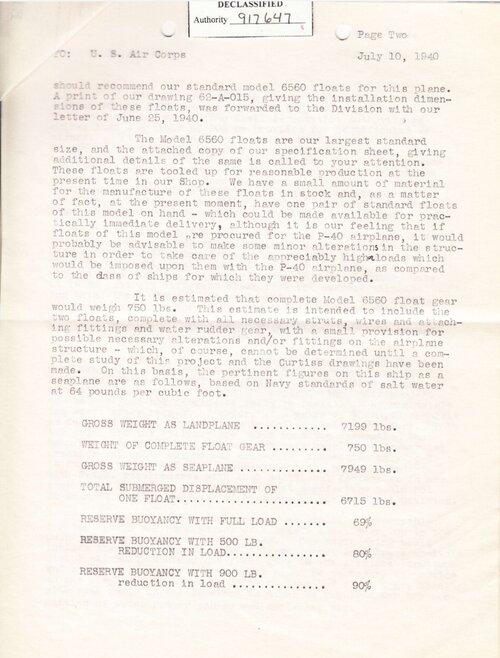 Screenshot_20230131_000256_Microsoft 365 (Office).jpg364.7 KB · Views: 24
Screenshot_20230131_000256_Microsoft 365 (Office).jpg364.7 KB · Views: 24 -
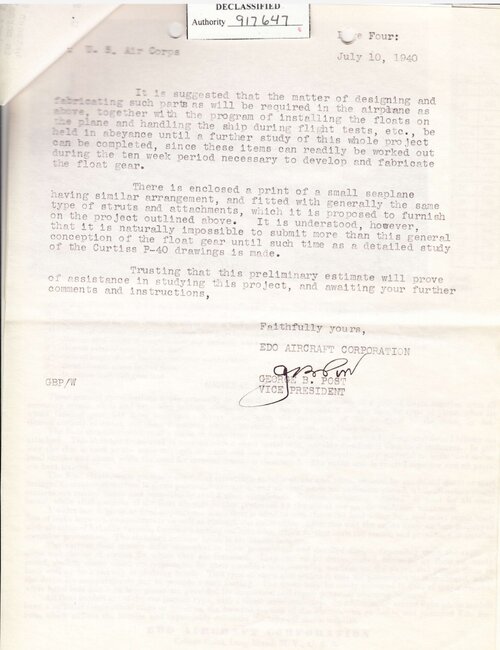 Screenshot_20230131_000315_Microsoft 365 (Office).jpg314.6 KB · Views: 22
Screenshot_20230131_000315_Microsoft 365 (Office).jpg314.6 KB · Views: 22 -
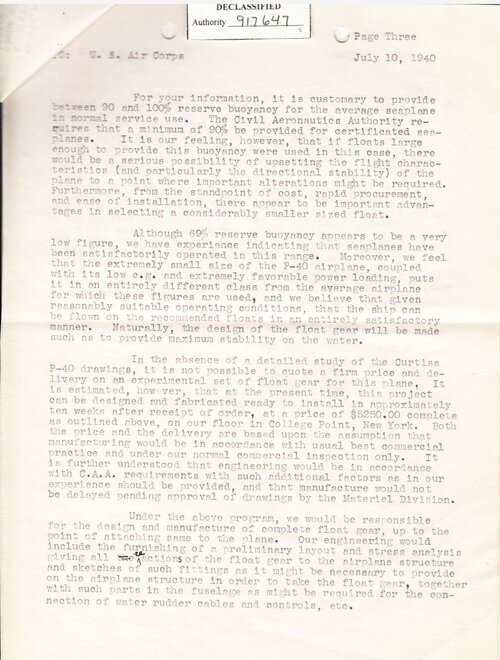 Screenshot_20230131_000306_Microsoft 365 (Office).jpg465.8 KB · Views: 36
Screenshot_20230131_000306_Microsoft 365 (Office).jpg465.8 KB · Views: 36 -
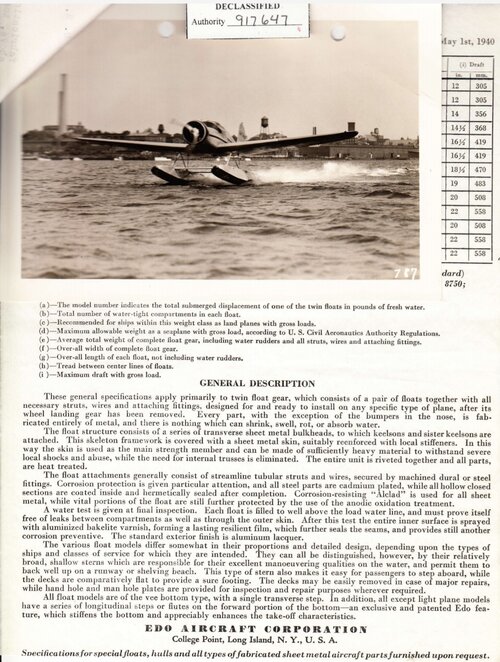 Screenshot_20230131_001205_Microsoft 365 (Office).jpg549.5 KB · Views: 43
Screenshot_20230131_001205_Microsoft 365 (Office).jpg549.5 KB · Views: 43 -
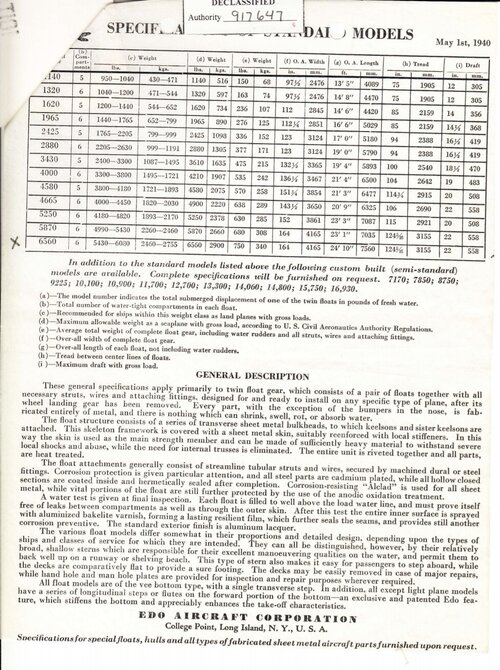 Screenshot_20230131_001224_Microsoft 365 (Office).jpg663 KB · Views: 43
Screenshot_20230131_001224_Microsoft 365 (Office).jpg663 KB · Views: 43

